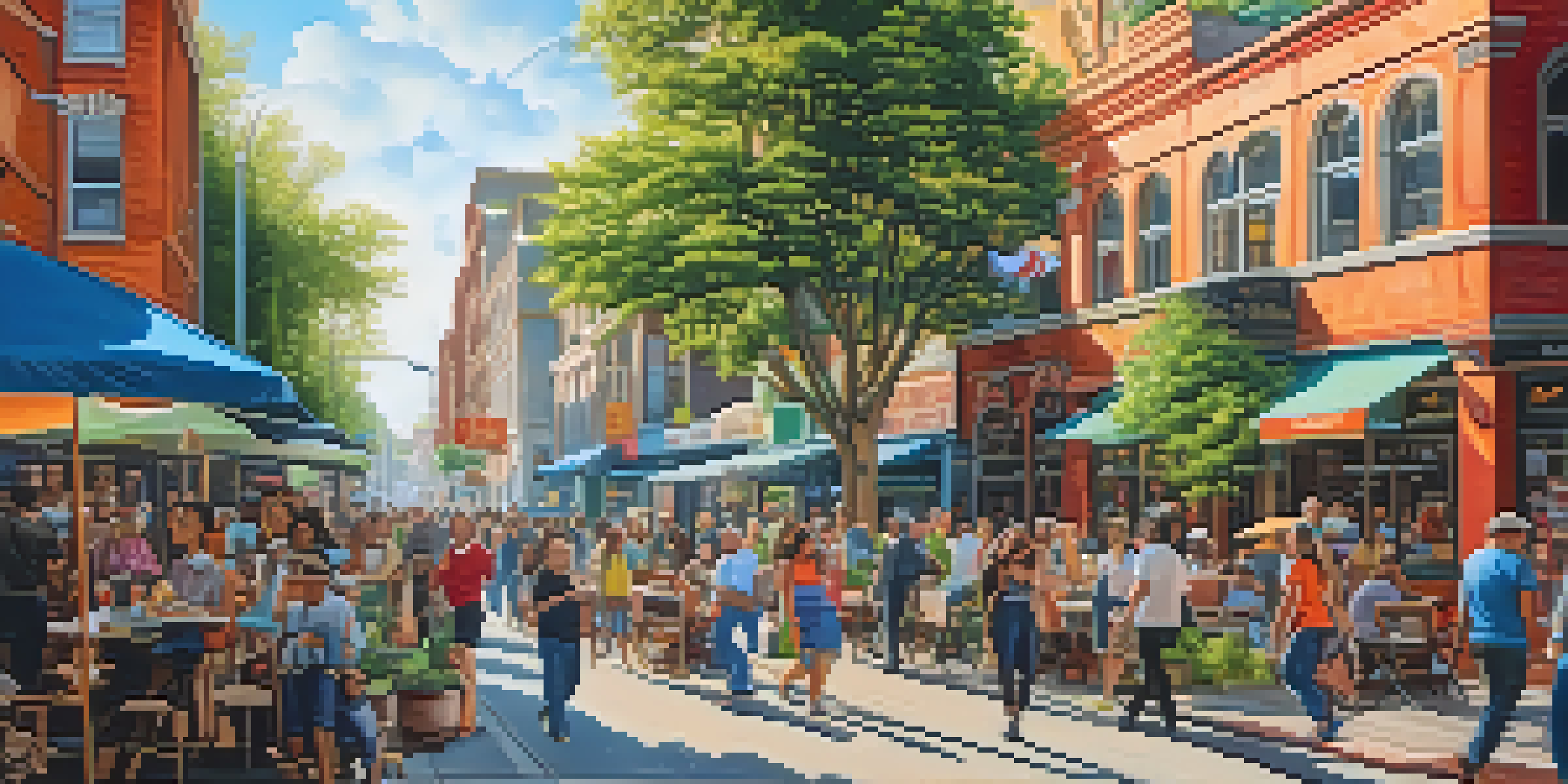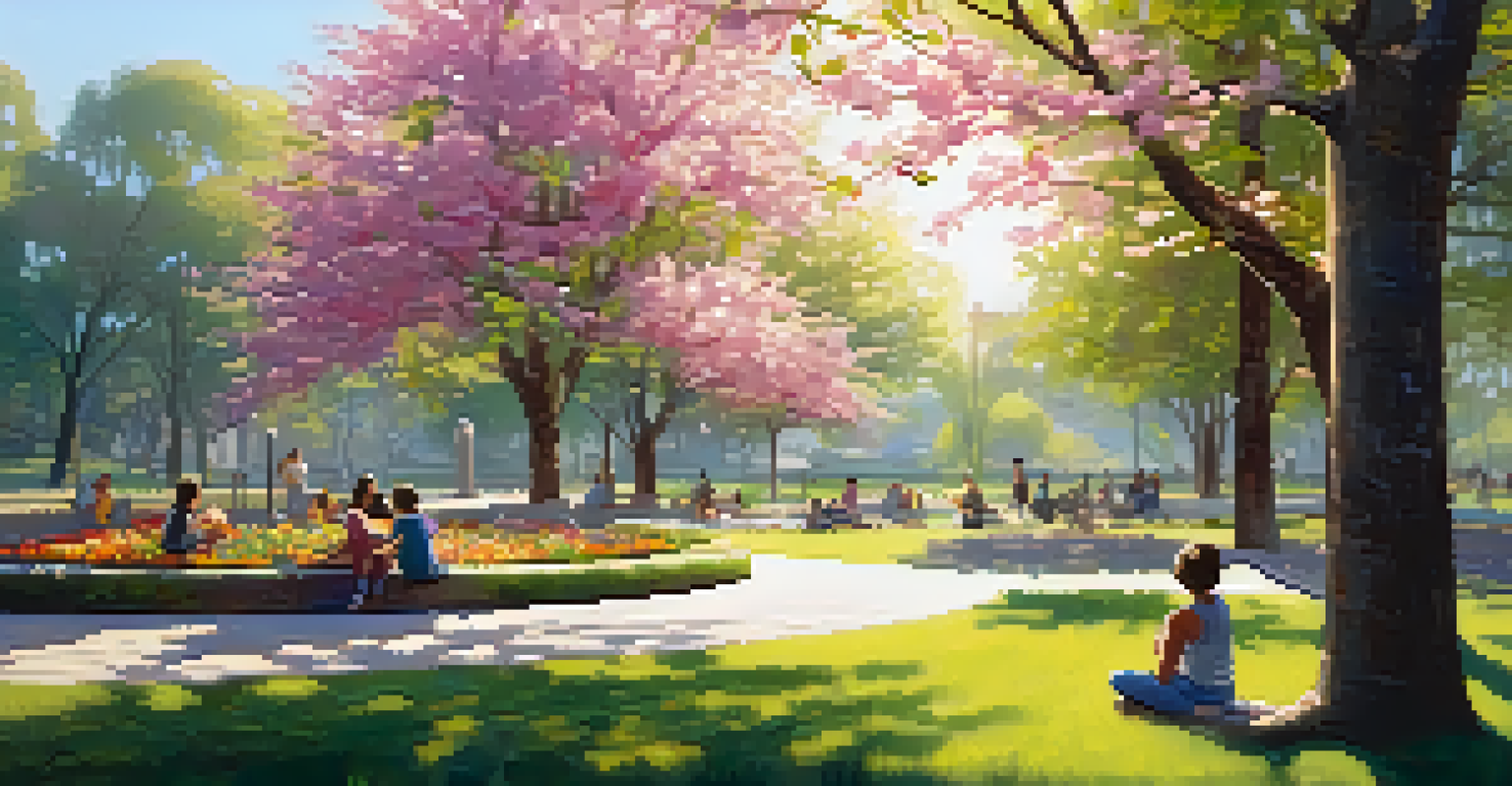The Impact of Public Art on Local Economies and Businesses

Public Art as a Catalyst for Economic Growth
Public art can serve as a powerful catalyst for local economic growth. When communities invest in art installations, they often see an influx of visitors and increased foot traffic. This surge in activity can lead to more customers for local businesses, creating a thriving atmosphere.
Public art is a reflection of who we are as a community. It tells our stories and brings us together.
Art installations not only beautify a space but also enhance its identity, making it a destination for both locals and tourists. For instance, cities known for their mural arts often attract art enthusiasts who explore the area, which benefits shops and eateries nearby. This kind of economic stimulation is vital for the sustainability of small businesses.
Furthermore, studies have shown that public art projects can lead to job creation in various sectors, from construction to tourism. By fostering creative industries, communities can build a more resilient economy that adapts to changing circumstances.
Enhancing Community Engagement Through Art
Public art has a unique ability to engage and unite communities. Murals, sculptures, and installations often tell local stories, sparking conversations among residents and visitors alike. This engagement fosters a sense of belonging and pride in the community, encouraging people to spend more time and money in the area.

Community art projects can also bring together diverse groups, promoting collaboration and understanding. For example, workshops that involve residents in the creation of public art not only beautify the neighborhood but also strengthen social ties. These projects can result in a more vibrant and cohesive community.
Public Art Boosts Local Economies
Investing in public art attracts visitors and stimulates spending, benefiting local businesses and creating jobs.
Increased community engagement often translates to support for local businesses, as people are more likely to shop and dine in places they feel connected to. This symbiotic relationship enhances the local economy and creates a thriving social fabric.
Attracting Tourists and Boosting Local Revenue
Tourism is a significant driver of local economies, and public art plays a crucial role in attracting visitors. Unique art installations can become iconic landmarks, drawing tourists who want to experience the local culture. For instance, cities like Philadelphia and Austin see thousands flocking to their vibrant street art scenes.
Art enables us to find ourselves and lose ourselves at the same time.
As tourists explore these artistic hotspots, local businesses benefit from their spending. Restaurants, hotels, and shops see increased patronage, which can lead to job creation and economic expansion. When visitors share their experiences online, it can further amplify interest in the area, creating a positive feedback loop.
Moreover, public art can be incorporated into local events and festivals, providing additional opportunities for businesses to showcase their offerings. This synergy between art and commerce can significantly enhance a community's economic landscape.
Increasing Property Values Through Public Art
One less obvious impact of public art is its ability to increase property values in the surrounding areas. When neighborhoods are adorned with visually appealing art, they often become more desirable places to live and work. This can lead to a rise in real estate prices, benefiting property owners and generating additional tax revenue for local governments.
Investors and homeowners are typically drawn to areas with vibrant public art scenes, as these spaces reflect creativity and community spirit. For instance, areas revitalized by public art often witness a transformation in their demographics, attracting a mix of residents and businesses seeking a lively atmosphere.
Community Engagement Through Art
Public art fosters a sense of belonging and encourages collaboration, strengthening social ties within the community.
As property values increase, so too does the potential for local governments to invest in further community improvements. This creates a cycle of growth that can be sustained over time, ensuring that the benefits of public art are felt for years to come.
Supporting Local Artists and Creative Economies
Public art initiatives often provide crucial support for local artists, enabling them to showcase their work and gain recognition. This not only enhances the cultural landscape of a community but also contributes to a thriving creative economy. By investing in local talent, cities can foster a vibrant arts scene that attracts both residents and visitors.
When local artists are commissioned for public art projects, they are able to earn a living while contributing to the community. This creates a sustainable model where art is not just a luxury but an integral part of everyday life. Additionally, local artists often collaborate with businesses, leading to unique partnerships that can further enhance the local economy.
The presence of local artists can also inspire future generations to pursue careers in the arts, creating a continuous cycle of creativity and economic contribution. By supporting local talent, communities can cultivate a rich cultural environment that benefits everyone.
Fostering Innovation and Creative Solutions
Public art can inspire innovation and creative thinking within communities. By introducing artistic elements into everyday life, residents may begin to see their environment through a different lens. This shift in perspective can lead to innovative ideas and solutions for local challenges, including economic ones.
For example, cities that embrace public art often become incubators for startups and creative businesses. These companies thrive in environments that celebrate creativity and originality, leading to job creation and economic diversification. As such, public art can help shape a community’s identity as a hub for innovation.
Art Enhances Property Values
Visually appealing public art increases property desirability, leading to higher real estate prices and greater tax revenue.
Moreover, the collaborative nature of public art projects encourages problem-solving and teamwork, skills that are invaluable in the business world. As residents come together to create and support art, they inadvertently build a stronger, more resilient local economy.
Creating a Sense of Place and Identity
Public art contributes significantly to a community’s sense of place and identity. Unique art installations can serve as symbols of local culture and history, giving residents a point of pride and connection. This strong sense of identity can foster loyalty among locals and attract visitors who want to experience the area's unique character.
When people feel a connection to their surroundings, they are more likely to invest in local businesses and participate in community events. This creates a vibrant economy where local shops and services thrive on the support of engaged residents. In turn, businesses that reflect the community’s identity can enhance the overall experience for both locals and tourists.

Furthermore, a strong sense of place can lead to initiatives aimed at preserving and promoting local culture. This ensures that public art remains a central part of the community’s identity, continually attracting interest and investment.